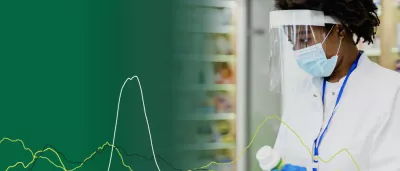Countries must sustain greater investment to prepare for next global pandemic.
SEATTLE, Wash. Jan. 24, 2023 – A new global analysis shows total health-related financial assistance to fight COVID-19 in low- and middle-income countries (LMICs) in the first two years of the pandemic was a record $37.8 billion, which was 810% higher than the total spent on pandemic preparedness the prior two decades (2000-2019). The peer-reviewed research paper that was published today in The Lancet Global Health is from the annual Financing Global Health report by the Institute for Health Metrics and Evaluation (IHME) at the University of Washington’s School of Medicine. To ensure countries are equipped to tackle the next global health threat and prevent a pandemic, maintaining adequate funds is crucial, which is challenging for the vast majority of LMICs, where substantial funding gaps persist.
“Despite the spike in spending due to pandemic-related support, sustaining this level of investment going forward is a serious concern,” said lead author Dr. Angela Esi Micah, assistant professor at IHME. “While countries may be expected to contribute to global pandemic preparedness as they are able, greater participation and coordination globally before the next pandemic are critical.”
Pandemic preparedness requires greater investment
The G-20 High Level Independent Panel (HLIP) has recommended greater domestic investment by national governments and donors in health over the next five years to manage the next global pandemic. For national governments in low- and middle-income countries, the HLIP recommends that countries increase government spending on health by 1% of its GDP. Currently, an estimated 13 countries devote less than 1% of their GDP to health. For donor governments, the HLIP recommends an additional $15 billion in support toward pandemic preparedness for the next five years.
In the current COVID-19 pandemic, a major portion of development assistance for health (DAH) has been funded by three countries: the US ($6.5B), Japan ($3.4B), and Germany ($3.3B). From 2020 to 2021, the two largest program areas of DAH were vaccine procurement and coordination, planning, and monitoring. DAH is the financial and in-kind contributions transferred through major development agencies to low- and middle-income countries for maintaining or improving health.
Spending in low- and middle-income countries does not correlate with need
The persistent challenge is a misalignment in the amount of donor funds provided for COVID-19 and where the virus has been the most debilitating. While knowing precisely how much funding each country needs to respond to COVID-19 was not in the scope of the report, researchers tracked where the money went. In the first two years of the pandemic, sub-Saharan Africa received 33.6% of DAH for COVID-19, yet 13.5% of COVID-19 deaths occurred in the region. By contrast, the South Asian region of Bangladesh, Bhutan, India, Nepal, and Pakistan included 27.2% of the world’s COVID-19 deaths that occurred in low- and middle-income countries, but it received only 14.8% of DAH for COVID-19.
2050 projections
The report explored historical health trends in 204 countries to project global health spending to 2050. The analysis included health funding patterns from 1990 to 2021 and the historic spike in COVID assistance from 2019 to 2020. Global health spending in 2019 reached $9.2 trillion or $1,183 per person, which was 2% higher than the previous year and 17.8% higher than in 2010. By 2050, it’s projected to reach $16.9 trillion or $1,827 per person.
Top three countries with the highest per-person health spending in 2050 are projected to be:
- US: $20,501
- Switzerland: $16,580
- Bermuda: $14,546
Top three countries with the lowest per-person health spending in 2050 are projected to be in sub-Saharan Africa:
- Somalia: $9
- Eritrea: $27
- South Sudan: $29
While most of the impoverished countries in the world have lower health spending and a higher growth in population, the wealthiest countries are shrinking in population.
Implications for diseases other than COVID-19
While spending on COVID-19 did not lead to major declines in funding in many health focus areas between 2019 and 2021, DAH for many areas did not grow. In 2021, $14.8 billion in DAH went toward reproductive, maternal, newborn, and children’s health. That’s 2.3% lower than in 2019, and it continued to decline during the pandemic. Our preliminary estimates of DAH for newborn and child health as well as reproductive and maternal health show that both decreased between 2019 and 2020. Funding for newborn and child health went down 2.6%, while reproductive and maternal health DAH declined 6.8% between 2019 and 2020. The figures underscore the importance of maintaining the sense of urgency of health care funding in general while also fighting a global pandemic.
The data visualization tool and the report, Financing Global Health 2021: Global Health Priorities in a Time of Change, are available on IHME’s website.
For interviews, journalists can contact: [email protected]
About the Institute for Health Metrics and Evaluation
The Institute for Health Metrics and Evaluation (IHME) is an independent global health research organization at the University of Washington that provides rigorous and comparable measurement of the world’s most important health problems and evaluates the strategies used to address them. IHME is committed to transparency and makes this information widely available so that policymakers have the evidence they need to make informed decisions on allocating resources to improve population health.
